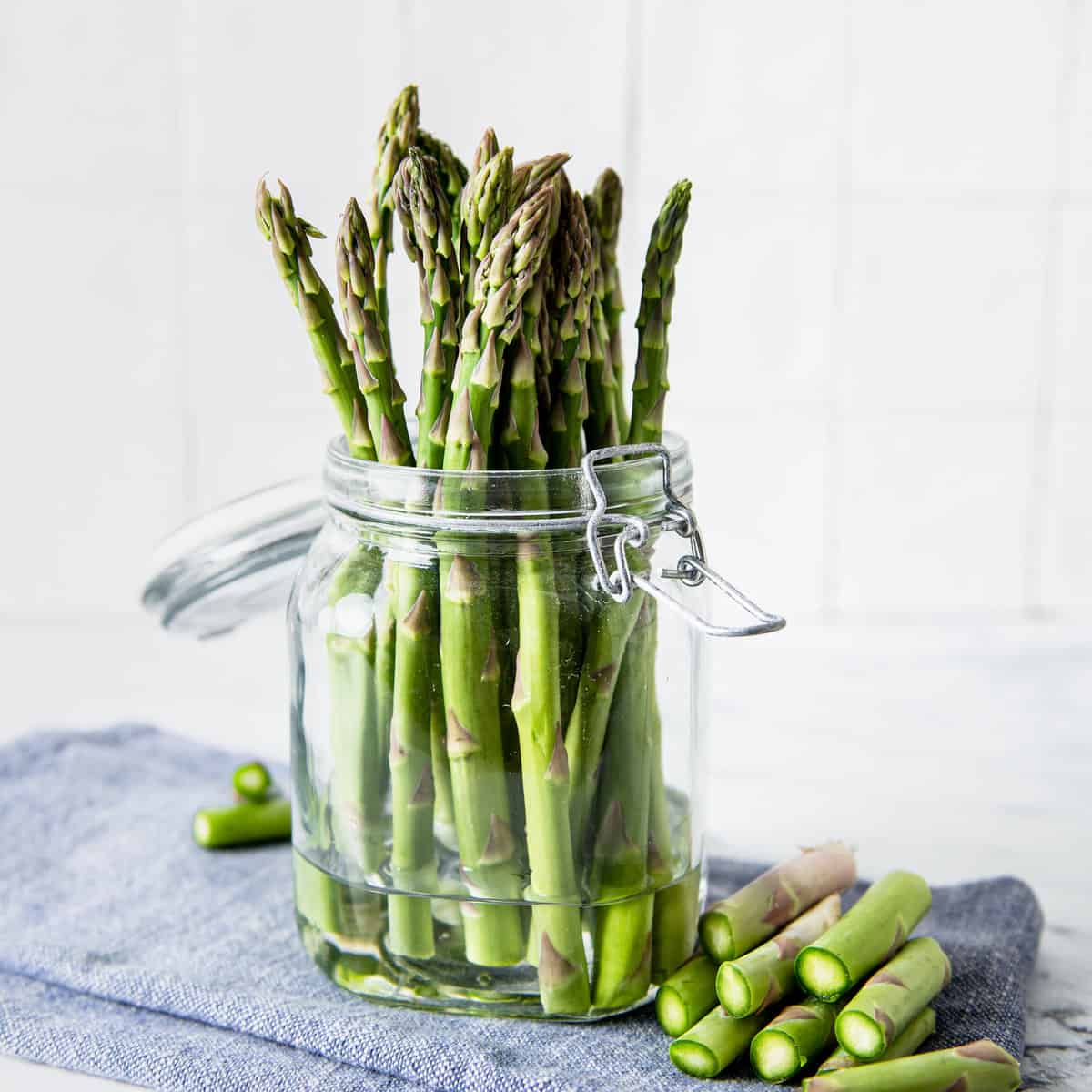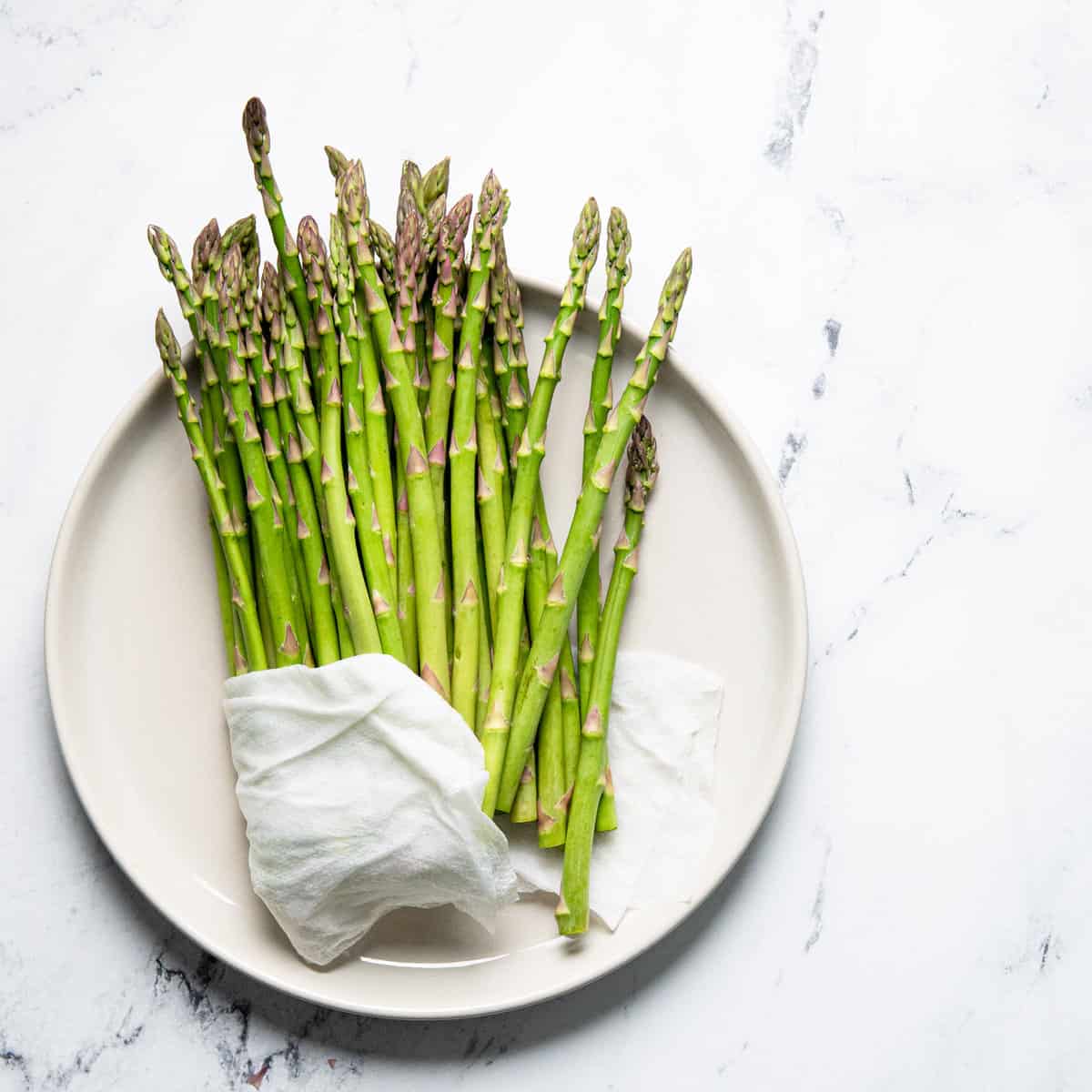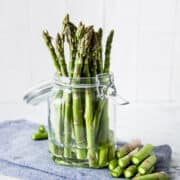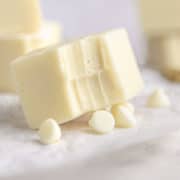Fresh asparagus is one of the most delicious vegetables there is and can be served as part of an appetizer, main course, or side dish. But asparagus stalks from the grocery store have probably been picked at least a few days before you can purchase them (or likely even more). So it's useful if you know how to store asparagus spears to keep them firm, fresh, and delicious.

Jump to:
Asparagus is a seasonal vegetable that you can use in a myriad of ways. There are different varieties including purple and white asparagus, each of which has a slightly different flavor. There are also different cooking methods such as steaming, pan-frying, boiling, stir-frying and grilling. It goes well with eggs so try asparagus in different ways like in egg puffs, omelets, or scrambled eggs.
One of my favorite ways to use it is to wrap a few spears of asparagus in pancetta or bacon and bake at 400°F for 20 minutes. You must try this, but don't forget to snap the woody ends off the asparagus first!
Asparagus contains fiber, folate, phosphorus, potassium, and Vitamins A, C, E, and K. It's also a low-calorie option, and half a cup is only 20 calories (unless you wrap it in bacon first of course!)
What is Asparagus?
Asparagus (Asparagus Officinalis) is also known as garden asparagus and sparrow grass (probably from someone mispronouncing "asparagus" a long time ago!) It's a flowering plant that is widely cultivated as a food crop and grows well in Western Asia as well as across most of Europe. Springtime is the peak season for asparagus and the time you'll find plenty of it in grocery stores and at farmers' markets and other fresh food markets.
Although green asparagus is the best-known variety, white asparagus is very common in Western Asia as well as in Europe. Perhaps you've been lucky enough to try these more unusual types. If not, look out for them and, if you are an asparagus fan, see which you like best.
If green asparagus shoots are covered up so they don't see the sunlight as they grow, they become white asparagus instead, which needs to be peeled because it has a woody skin but a delicious, tender flavor.
Another variety is purple asparagus which has a delicate, nutty taste and is slightly sweeter than the other kinds. You can't always find these varieties, although green asparagus is pretty common even outside peak season when it's typically imported.
How to Select the Best Asparagus
The best asparagus stalks are going to be firm and plump with tightly closed tips. It's best to buy from somewhere that keeps the asparagus sitting in an inch of water or at least keeps it chilled for freshness instead of at room temperature. Also, choose a bunch of asparagus where the stalks are more or less the same thickness, since the thicker a stalk is the longer it will take to cool and it's easier to cook the spears all at once than start cooking the thick ones then having to add the thin ones later.
The choice of thin stalks or thick ones is up to you. Both are good, but thin stalks are more delicate and cook faster, while thicker ones have a more robust taste. The tips of green asparagus might be slightly purple, which is fine, but reject any asparagus with mushy tips because they're definitely past their best.

How to Store Asparagus
Since asparagus is typically bought in a bunch secured with a rubber band, you might not be using all of it immediately or at the same time. For this reason, it's worth knowing the best and easiest way to keep raw asparagus fresh until you use it, especially since this vegetable doesn't keep for more than a few days. This is the best method I've found to store asparagus:
- Treat your fresh asparagus like a bouquet of flowers, so the first thing to do is snap or snip off the woody ends.
- Put an inch or 2 of cold water in a mason jar or similar glass jar then add the vegetables with the tips of the asparagus pointing upwards.
- Cover loosely using plastic wrap or a plastic bag.
- Keep it refrigerated, changing the water for fresh water every day.
Another method if you don't have a glass jar or the space to have one in the fridge is to wrap the ends of the asparagus in damp paper towels and keep the stalks in a plastic bag. Replace the paper towels every day.
If you have leftover chopped asparagus, the best option is to keep it in a plastic container in the crisper drawer and use it within a couple of days.
Even when you store asparagus in a jar of water, the best way, it still isn't going to last more than 3 or 4 days max. The only exception is canned asparagus, but due to its somewhat mushy texture and lack of flavor, you probably won't want to use this kind unless you're making a pureed asparagus soup where the texture won't really matter.
If you want to freeze asparagus, that's another possibility. A great way to do this is to trim the spears and then blanch the stalks in a large pot of boiling water for a couple of minutes. Next, plunge the asparagus into an ice bath (large bowl of ice water) to stop the cooking process, and then freeze it in a freezer bag or airtight container for up to 3 months. Although it will be slightly softer than fresh asparagus when thawed, the difference in flavor and texture should be minimal.
How to Tell if Asparagus Has Gone Bad
As asparagus gets older, it wilts, wrinkles, and turns limp. Eventually, the tips will go mushy and develop black spots and then go completely black, so you can usually tell if asparagus has gone bad just by looking it at. There are other factors to check for as well: asparagus that's sticky or slimy, feels mushy, smells bad, or has visible mold shouldn't be eaten. If it's slightly less firm but otherwise okay, it's fine to eat, else throw it out.
Common Questions
It's usually best to purchase fresh produce when it's in season since you will be getting a better, fresher purchase. However, that isn't always possible. Asparagus is in season during the spring, but you can find imported asparagus year-round. Perhaps you want to make a favorite asparagus side dish in the winter, in which case imported asparagus will work. But, for the freshest results, treat yourself to some fresh seasonal asparagus from a farmers' market - you'll love it!
Asparagus is typically enjoyed in its cooked form, but you might be curious whether you can eat it raw as well. Actually, it's perfectly safe to consume raw and, if you like it this way, pairs beautifully with ranch dressing, melted butter, or your dip of choice. I sometimes add some to a vegetable crudité platter, along with raw broccoli, carrots, cauliflower, and other crunchy options for dipping.
Now, this is completely optional. Personally, I never peel green asparagus but the thick white stalks do have a thin skin on, so I prefer to peel those. As for purple asparagus, this is also optional but if you peel the stalk and leave the tips intact you'll have green stalks with purple tips which look very special, so it's worth peeling the stalk for that effect!

Facts You Didn’t Know
- Asparagus was first cultivated in Ancient Greece about 2,500 years ago and has been grown in the United States for nearly 150 years.
- White asparagus is simply green asparagus that's kept covered in the ground during growth so the sunlight doesn't reach it to turn it green.
- If the temperature is above 90°F, asparagus can grow up to 7 inches in just one day! Growing your own? Tell the kids to watch and maybe they can see it grow!
- Trim the bottoms off your asparagus before storing it, either with a sharp knife or by snapping it. Asparagus spears will naturally snap at the point between the tender stalk and the woody bottom. Use a sharp knife if you want a smooth rather than a ragged break.
Knowing some easy ways to choose, store and prepare asparagus means you can buy a bunch of this delicious vegetable and make all kinds of nutritious dishes with it. The life of your asparagus depends largely on how well you store it, so follow the above tips to maximize its shelf life.
There are plenty of ways to use it, including simply sautéing it in olive oil until fork-tender. I prefer mine al dente (with a little crunch) and it only takes a few minutes to cook thin spears of asparagus.














